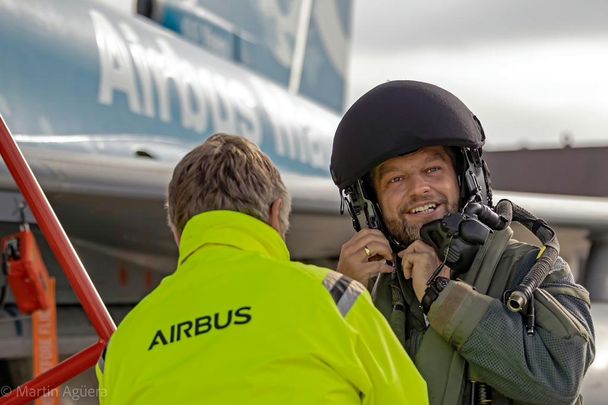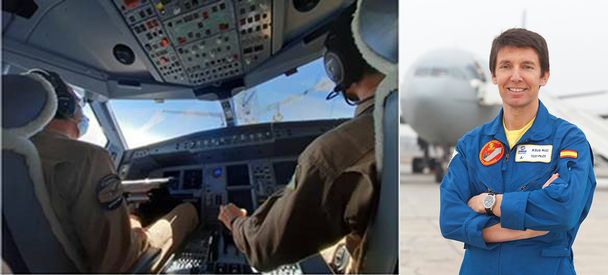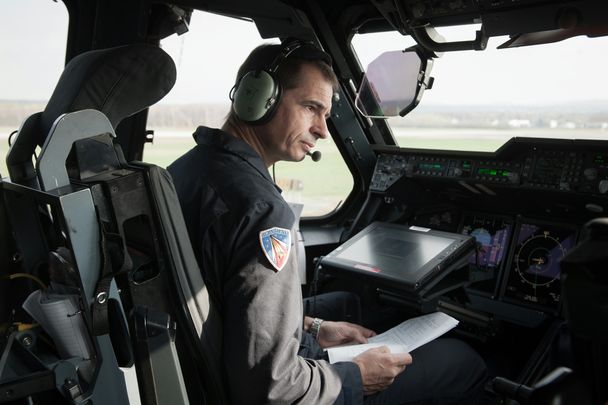Airbus’ military aircraft flight test team pushes the limits and beyond

“The motto of our team is ‘to the edge and beyond’. It reflects our mission: to ensure that every aircraft we deliver is safe and that all its operators are able to carry out every mission.”
Ignacio Lombo heads Airbus Defence and Space's Flight Test team, which consists of around 50 pilots, flight engineers, flight mechanics, loadmasters and A330 MRTT boom operators and UAV operators. They are responsible both for flying the aircraft before delivery and for working with engineering teams to develop the capabilities of combat aircraft such as the Eurofighter and Tornado, military transport aircraft such as the A400M and C295, and refuelling aircraft such as the A330 MRTT.
Testing and developing aircraft for those who defend our freedom
The majority of Airbus' flight test team comes from the military, creating an unbreakable bond with the end users: the members of the armed forces who put themselves in harm's way to defend national sovereignty and stability.

Carlos Pinilla, call sign Pini, has more than 32 years of experience as a flight test pilot. "We are qualified to fly many different aircraft, from flight envelope testing in a campaign to ground taxiing. One day we might be flying an A400M at an airshow, the next day a Eurofighter, the next week a training mission with a customer. Whatever the customer needs."
"We are fully aware of what we are doing, our job is to minimise risk. If we make a bad product, we will put the Air Force, which guarantees our security, in difficulty. It is a vocation of service to society that we never forget," stresses Eurofighter test pilot Carlos Pinilla, a former Spanish Air Force pilot. A spirit shared by everyone on the flight test team. "I've never forgotten what my former German Air Force Commander told me when I joined Airbus: 'Whenever you're in your new job, don't forget where you came from. All the development work we do is for them: my responsibility is to provide the best possible defence system for the Air Force to the best of my ability," says Stephan Leuthner, Experimental Test Pilot and Project Pilot for the Future Combat Air System's Next Generation Fighter.
Over the years, Airbus has delivered some 1,900 military aircraft whose capabilities continue to evolve throughout their service life. "Our relationship with the air forces is very close, it's a give and take. With a constantly evolving fighter, there will always be issues to be resolved, so our job is to identify them and share the necessary information with the operational pilots,” explains Stephan.

Stephan Leuther, an aerospace engineer by training, became a pilot in the German Air Force in 1997 and received his pilot wings, also known as aviation or pilot badges, from his father in 2005. Stephan's call sign is Grisù [a young dragon who dreams of becoming a firefighter, a character from an Italian cartoon series from the 60s and 70s].
He and his colleagues are currently working on improving the weapons integration, electronics and intelligence capabilities of the German Tornado fleet, while the focus for the Eurofighter is the integration of the Electronically-Scanned (E-Scan) radar . "It will give fighter pilots an improved, much broader situational picture, while detecting multiple ground and air targets simultaneously and more quickly. It is an amazing system, it will be the best on the market and it will make the pilot's job easier".
From military transport with the A400M and A330 MRTT to the Eurofighter
"The difference between flying a military transport like the A400M and a fighter like the Eurofighter is a bit like driving a Mercedes in the Dakar Rally and a Ferrari. They have different speeds and accelerations, with a much higher level of interaction in the fighter cockpit," explains Ignacio Lombo.
"The Eurofighter is a performance machine, like a Formula 1 car, and all decisions have to be made quickly and with a high degree of confidence," continues Stephan, who also tests Airbus A320 aircraft. "In the civilian world, the challenge is communication with the crew and complex scenarios such as landing in crosswinds with poor visibility."
"In a tanker like the A330 MRTT, the flight is much calmer, it's like a ballet dance," says Jesús Ruiz, a military transport and fighter test pilot. "What is different is the coordination with the fuel-receiving aircraft and the boom operator, rather than the pure flight management." He is leading the flight test campaign for the Auto'Mate project, which is developing autonomous and unmanned air-to-air refuelling technologies.
"In reality, what makes a mission more complex is the tactical environment. The number of aircraft involved, the number of enemy radars, if you have limited time, weather restrictions, if the operation is at night or involves flying at low altitude... The secret is to be prepared for everything, from a refuelling or medical evacuation mission that can last 16 hours to a 15-minute Eurofighter air policing mission," adds Jesús.

During COVID-19 in 2020, Jesús Ruiz coordinated a 23-hour, 30-minute round-trip A330 flight from Getafe to Tianjin, China, to deliver medical supplies and masks to Europe's national health services. "Everyone contributed, from the A400M colleagues to the Spanish Air Force, who provided 200 cargo straps and 20 cargo nets. Thanks to the tremendous effort of all the teams, we were able to turn a commercial aircraft into a cargo aircraft in a single weekend.
"If I had to choose, I would say that air-to-air refuelling as a receiver was the most challenging capability in the development of the A400M," Ignacio reflects. "Through various steps, we gradually defined the flight control laws to perform the receiver role in a simple way compared to other platforms. As a pilot, it was fantastic to fly on different flight control laws and, step by step, we managed to achieve the perfect manoeuvrability of the aircraft".

Ignacio Lombo has been at the heart of the A400M development from the very beginning. "We pushed the test aircraft to the limit in terms of speed, Mach, height, altitude, load factor (Gs) and almost tore its skin off! The A400M has exceeded all expectations in all types of operations with superior performance".
What makes a good pilot?
Aviation pioneer Wilbur Wright said it was possible to fly without engines, but not without knowledge and skill. "Another essential quality of a pilot is calmness, as well as the ability to analyse. You have to control your reactions, because faster is not always better. You have to make decisions at the right time and have the knowledge of the situation that only experience can give you," says Ignacio, whose vocation, like that of many of the members of his team, stems from his family background. "I've always smelled kerosene in my house. I ate in the pavilions with the pilots, watched the planes and was always fascinated by them," he says.

Ignacio Lombo
The same passion beats in the heart of Stephan Leuthner, who has dreamed of becoming a pilot since his first flight in a motor glider at the age of 6. "You have to be aggressive in the way you pursue your goals during a flight and have a lot of self-confidence, but you also have to be self-reflective, don't act like a cowboy. The most important quality of a good flight test pilot is honesty: be aware of your limitations, keep improving, and if you see a problem, assess whether it was your fault or a problem with the aircraft. Other people's lives depend on your honesty.”
Stephan Leuthner
Jesús Ruiz points out another essential characteristic of a good pilot: the "we" versus the "I". "Teamwork is a fundamental part of our DNA. For example, you can fly in a formation of 3 or 4 fighters and in the middle of an operation the dynamics change and you take over the leadership of the team. Knowing how to follow is as important as knowing how to lead.
"Being a pilot is made up of an infinite number of small daily victories," summarises Carlos Pinilla, who as a child collected aviation badges and models and made his own aeroplane albums by cutting out photos from magazines.
"There are many special moments in your career: your first flight, when you change aircraft, your first international exercise, the first time you fly as a mission commander... But in reality, being a pilot is about taking off and landing every day, those little daily victories".
